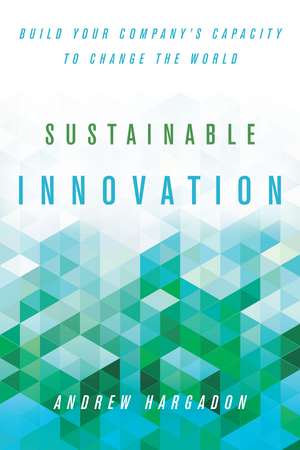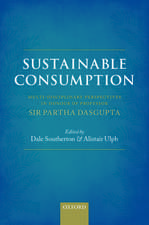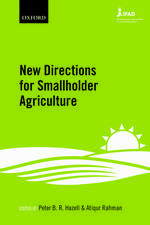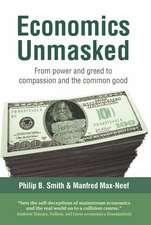Sustainable Innovation: Build Your Company’s Capacity to Change the World: Innovation and Technology in the World E
Autor Andrew Hargadonen Limba Engleză Hardback – 23 iun 2015
While other books treat innovation across sectors equally, Hargadon argues that most effective innovation strategies hinge on attention to the context in which they are pursued. Instead of relying on a stale set of "best practices," executives must craft their own strategies based on the particulars of their industries and markets. But, there are some rules of the road that foster a triple bottom line; this book provides a research-based framework that outlines the critical capabilities necessary to drive sustainable innovation: a long-term commitment, nexus work, science and policy expertise, recombinant innovation, and robust design. Sustainable Innovation draws on a wide range of historical and contemporary examples to show business readers and their companies how to stand on the shoulders of successful pioneers.
Preț: 295.51 lei
Nou
56.54€ • 59.20$ • 46.79£
Carte disponibilă
Livrare economică 15-29 martie
Specificații
ISBN-10: 080479250X
Pagini: 248
Dimensiuni: 152 x 229 x 23 mm
Greutate: 0.51 kg
Editura: Stanford University Press
Colecția Stanford Business Books
Seria Innovation and Technology in the World E
Recenzii
Notă biografică
Cuprins
This chapter defines sustainable innovation, describes the nature of change in markets and industries, and the need to recognize the challenges inherent in and capabilities required for sustainable innovation. Using the evolution of the electric power industry in the 1800s, this chapter introduces the long fuse, big bang framework to describe how industrial change often begins slowly and with great uncertainty until a range of technical, social, economic and political elements are present but uncoordinated, before a small group of innovators, entrepreneurs, policy makers and others trigger a rapid transition to a coordinated state that, in turn, removes uncertainty and attracts and aligns innovative efforts. Further, this chapter demonstrates that sustainability remains, for many industries, on the cusp of such a rapid transition¿creating momentary windows of opportunity for companies with the right capabilities to lead sustainable change.
This chapter introduces the first capability necessary for leading sustainable innovation: commitment. By defining commitment as a capability, rather than a decision, this chapter recognizes the embedded nature of the activity and its dependence on the particular individuals, structures, norms and values, reward systems, and resources of the organization. The difficulties preventing companies from making long-term commitments are described and explicated through extant theory. Further, this chapter presents a process, the innovation strategy framework, for defining and translating such commitments into a limited and specific set of innovation initiatives that, in turn, illuminate the particular challenges the company will face and capabilities they will need.
This chapter introduces and describes five significant challenges that define the pursuit of sustainable innovation and, in combination, distinguish such a pursuit from innovation efforts in other sectors (e.g., in smartphone applications, consumer packaged goods, enterprise solutions, ecommerce, etc). These challenges include declining resources; brownfield markets; the trade-off between scale, reliability, and profit; compounding uncertainties; and the breakthrough bias. Each challenge is described and illustrated with brief examples.
This chapter introduces the capability of nexus work, which recognizes the process of constructing coordinated networks from previously incoherent and uncoordinated elements¿people, organizations, technologies, policies, and ideas. The resulting networks, driven by a single set of organizing principles, precipitates the big bang introduced in the first chapter and is essential to overcoming the extant industrial networks described in the challenge of innovating in brownfield markets. Using case examples including Edison's role in creating order within the electric industry and Daimler's role in constructing a viable network enabling clean diesel technology, this chapter describes the individuals, activities, and other organizational components of nexus work as a capability.
This chapter introduces the ability to recognize the current landscape of relevant science and policies affecting a company's innovation efforts, to predict the evolution of both the science and policy, and even to drive necessary changes in that science and policy in order to enable innovation. Against the challenges of innovating in the face of declining resources and in brownfield systems, particularly, this chapter describes the need for companies to be able to understand, predict, and shape the science and policies that define the competitive landscape.
This chapter introduces recombinant innovation as the ability to recognize, adapt and combine the elements of existing solutions into novel offerings that can scale effectively, quickly, and profitably and discusses the role this capability plays in overcoming the challenges of scale, reliability and profitability and of the breakthrough bias. It discusses the organizational activities, structures, and reward systems that constitute recombinant innovation and illustrates these with nodern and historic examples.
This chapter describes robust design, the ability to employ design in ways that domesticate radical change, reducing resistance and enabling adoption of novel and transformative technologies into brownfield markets and industries. Robust design represents an alternative to design approaches that seek to accentuate the differences between novel products and their competitors. This chapter describes the central role such robust design capabilities played in enabling historic and current innovation efforts.
This chapter describes business model innovation as the ability of your organization to explore and ultimately construct novel revenue models, distribution channels, value propositions and new relationships with suppliers, partners, distributors, consumers and regulators. Business model innovation develop and deliver new dimensions of value in a company's offerings, reducing reliance on declining resources and isolates new technologies from the limitations that are placed on its performance in order to fit within brownfield systems.
This chapter summarizes the central premise of the book, that the pursuit of sustainable innovation requires a relatively unique and intentionally constructed set of capabilities which, in turn, are driven by the particular challenges of an organization's innovation strategy. In addition to reviewing these challenges and capabilities, this chapter provides several additional insights gleaned from the research.



































